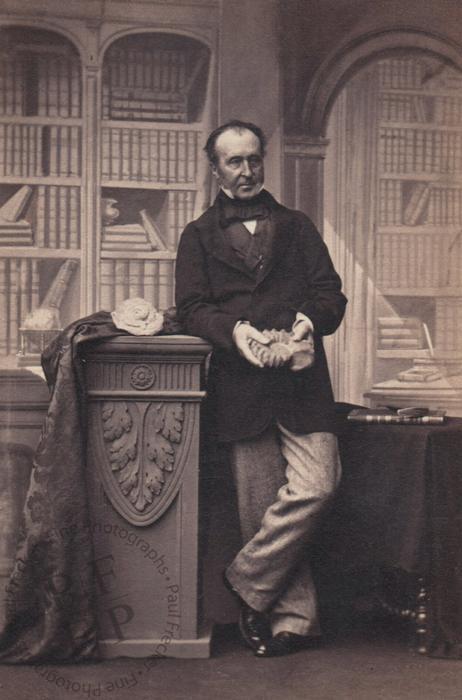Sir Roderick Murchison
(1792-1871)
10 October 1860
Volume 2, page 33, sitting number 1432.
Born at Tarradale near Muir of Ord in Ross-shire, the British geologist Roderick Impey Murchison was the son of Kenneth Murchison (died 1796). He attended Durham grammar school, and then the military college at Great Marlow to be trained for the army. In 1808 he landed with Wellesley in Galicia, and was present at the actions of Roliça and Vimiero. Subsequently under Sir John Moore he took part in the retreat to Corunna and the final battle there.
After eight years of service he left the army, and married the daughter of General Hugonin, of Nursted House, Hampshire. The couple spent two years in Europe, mostly in Italy. They then settled in England in 1818, and Murchison made the acquaintance of Sir Humphrey Davy, who urged him to turn his energy to science. He became fascinated by the young science of geology. He joined the Geological Society of London and soon showed himself one of its most active members.
Exploring the geology of the south of England with his wife, he devoted special attention to the rocks of the north-west of Sussex and the adjoining parts of Hampshire and Surrey, on which, aided by Fitton, he wrote his first scientific paper, read to the society in 1825. Turning his attention to Continental geology, he explored with Lyell the volcanic region of Auvergne, parts of southern France, northern Italy, Tyrol and Switzerland. A little later, with Sedgwick as his companion, he attacked the difficult problem of the geological structure of the Alps, and their joint paper giving the results of their study is one of the classics in the literature of Alpine geology.
In 1831 he went to the border of England and Wales, to attempt to discover whether the greywacke rocks underlying the Old Red Sandstone could be grouped into a definite order of succession. The result was the establishment of the Silurian system under which were grouped for the first time a remarkable series of formations, each replete with distinctive organic remains other than and very different from those of the other rocks of England. These researches, together with descriptions of the coal-fields and overlying formations in south Wales and the English border counties, were embodied in The Silurian System (1839).
The establishment of the Silurian system was followed by that of the Devonian system, an investigation in which Murchison assisted, both in the south-west of England and in the Rhineland. Soon afterwards Murchison projected an important geological campaign in Russia with the view of extending to that part of the Continent the classification he had succeeded in elaborating for the older rocks of western Europe. He was accompanied by Edouard de Verneuil (1805-1873) and Count Alexander von Keyserling (1815-1891), in conjunction with whom he produced a work on Russia and the Ural Mountains. The publication of this monograph in 1845 completes the first and most active half of Murchison’s scientific career.
In 1846 he was knighted, and in the same year he presided over the meeting of the British Association at Southampton. During the later years of his life a large part of his time was devoted to the affairs of the Royal Geographical Society, of which he was in 1830 one of the founders and of which he was four times president (1843-1845, 1851-1853, 1856-1859 and 1862-1871).
The chief geological investigation of the last decade of his life was devoted to the Highlands of Scotland, where he believed he had succeeded in showing that the vast masses of crystalline schists, previously supposed to be part of what used to be termed the Primitive formations, were really not older than the Silurian period, although subsequent research has shown that he was mistaken.
In 1855 Murchison was appointed director-general of the Geological Survey of the United Kingdom and director of the Royal School of Mines and the Museum of Practical Geology in Jermyn Street, London. In 1863 he was made a KCB, and three years later was raised to a baronetcy. Learned societies of his own country bestowed their highest rewards upon him (the Royal Society gave him the Copley medal, the Geological Society its Wollaston medal, and the Royal Society of Edinburgh its Brisbane medal) and there was hardly a foreign scientific society of note which had not enrolled his name among its honorary members. The French Academy of Sciences awarded him the prix Cuvier, and elected him one of its eight foreign members in succession to Michael Faraday.
One of the closing public acts of Murchison’s life was the founding of a chair of geology and mineralogy in the University of Edinburgh. Under his will, there was established the Murchison Medal and geological fund to be awarded annually by the council of the Geological Society in London.
He died at 16 Belgrave Square, one of the grandest squares in London, on 22 October 1871, leaving an estate valued at £300,000.

